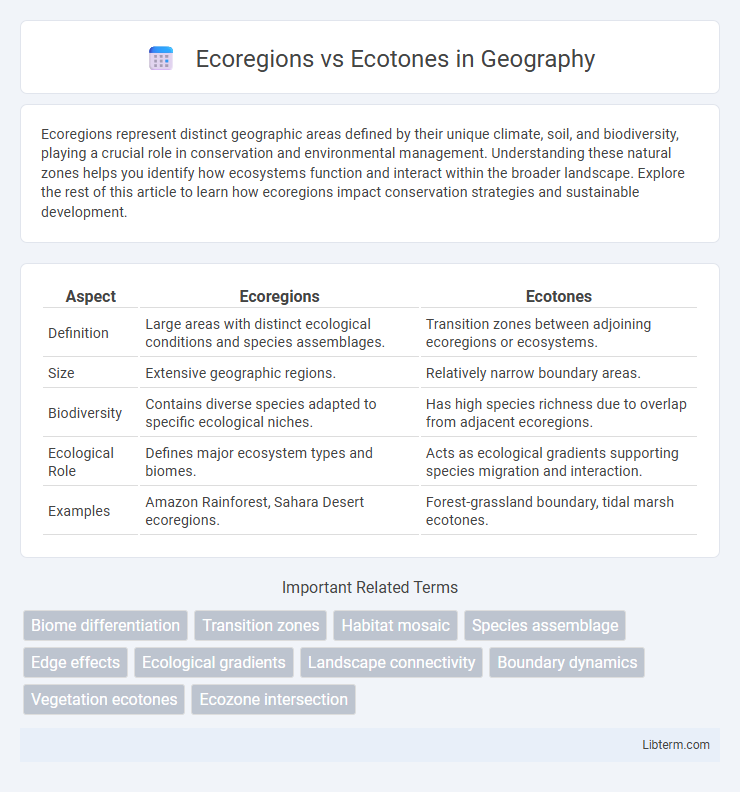Ecoregions represent distinct geographic areas defined by their unique climate, soil, and biodiversity, playing a crucial role in conservation and environmental management. Understanding these natural zones helps you identify how ecosystems function and interact within the broader landscape. Explore the rest of this article to learn how ecoregions impact conservation strategies and sustainable development.
Table of Comparison
| Aspect | Ecoregions | Ecotones |
|---|---|---|
| Definition | Large areas with distinct ecological conditions and species assemblages. | Transition zones between adjoining ecoregions or ecosystems. |
| Size | Extensive geographic regions. | Relatively narrow boundary areas. |
| Biodiversity | Contains diverse species adapted to specific ecological niches. | Has high species richness due to overlap from adjacent ecoregions. |
| Ecological Role | Defines major ecosystem types and biomes. | Acts as ecological gradients supporting species migration and interaction. |
| Examples | Amazon Rainforest, Sahara Desert ecoregions. | Forest-grassland boundary, tidal marsh ecotones. |
Introduction to Ecoregions and Ecotones
Ecoregions are extensive areas defined by distinct assemblages of ecosystems, climate, soil, and topography that support characteristic flora and fauna, facilitating region-specific conservation strategies. Ecotones represent transitional zones between adjacent ecoregions or ecosystems, characterized by a mixture of species from both neighboring areas and often exhibiting higher biodiversity and ecological interactions. Understanding the spatial dynamics and ecological functions of ecoregions and ecotones is crucial for effective environmental management and biodiversity preservation.
Defining Ecoregions: Key Characteristics
Ecoregions are geographically distinct areas defined by consistent climate, soil, and vegetation patterns that support specific ecosystems and biodiversity. They exhibit relatively uniform environmental conditions and species assemblages, enabling focused conservation and resource management strategies. Unlike ecotones, which are transitional zones between ecoregions, ecoregions maintain ecological integrity with stable boundaries and characteristic flora and fauna.
What Are Ecotones? Explanation and Importance
Ecotones are transition zones between two distinct ecoregions where diverse ecosystems overlap, creating unique habitats rich in biodiversity. These areas serve as critical interfaces that support species from adjoining ecosystems and often contain endemic organisms adapted to the mixed environmental conditions. The ecological importance of ecotones lies in their role as biological corridors, enhancing genetic exchange and ecosystem resilience against environmental changes.
Major Differences Between Ecoregions and Ecotones
Ecoregions are large, relatively homogenous areas defined by similar climate, soil, and ecological features, supporting distinct communities of plants and animals. In contrast, ecotones are transitional zones where two or more ecoregions or ecosystems overlap, leading to higher biodiversity and species interactions. Major differences include the scale, with ecoregions spanning broad landscapes and ecotones being narrow boundary areas, and the ecological functions, where ecoregions provide stable habitats while ecotones serve as dynamic interfaces facilitating species migration and genetic exchange.
Ecological Roles of Ecoregions
Ecoregions represent extensive geographic areas defined by distinct climate, soil, and ecological communities, serving as critical units for biodiversity conservation and ecosystem management. They provide stable habitats that support species adaptation and maintain ecological processes such as nutrient cycling and energy flow across landscapes. By preserving ecoregions, conservation efforts can maintain ecosystem resilience and promote the sustainability of natural resources within different biomes.
Functions and Significance of Ecotones
Ecotones serve as critical transition zones between distinct ecoregions, fostering biodiversity by supporting species from adjacent habitats and unique organisms adapted specifically to these boundary areas. They function as natural buffers that enhance ecosystem resilience, facilitate nutrient cycling, and act as corridors for wildlife movement, thereby maintaining ecological connectivity. The significance of ecotones lies in their role as hotspots for ecological processes, genetic exchange, and environmental monitoring, making them vital for conservation and habitat management efforts.
Examples of Ecoregions Around the World
Ecoregions are distinct ecological zones defined by unique climate, soil, and vegetation patterns, such as the Amazon Rainforest ecoregion in South America, the Sahara Desert ecoregion in Africa, and the Great Barrier Reef marine ecoregion in Australia. These regions support specific plant and animal communities adapted to their environmental conditions, whereas ecotones represent transitional zones where two or more ecoregions overlap, creating areas of high biodiversity. Examples of ecotones include the forest-grassland ecotone in the African savanna and the coastal salt marsh ecotone between marine and terrestrial ecosystems.
Notable Ecotone Zones and Their Biodiversity
Notable ecotone zones, such as the Amazon rainforest-savanna transition and the Great Plains-forest boundary in North America, exhibit unique biodiversity due to the convergence of species from adjacent ecoregions. These ecotones support diverse flora and fauna adapted to the varying environmental gradients and edge effects characteristic of these transitional areas. The increased species richness in ecotones contributes significantly to regional ecological resilience and evolutionary processes.
Human Impact on Ecoregions and Ecotones
Human activities significantly alter ecoregions through deforestation, urbanization, and agriculture, leading to habitat loss and biodiversity decline. Ecotones, being transition zones between ecoregions, are especially sensitive to human impact, often experiencing changes in species composition and ecosystem functions due to pollution and climate change. The degradation of ecoregions and ecotones disrupts ecological balance and reduces ecosystem services critical for human survival.
Conservation Strategies for Ecoregions and Ecotones
Conservation strategies for ecoregions emphasize preserving large-scale biodiversity by maintaining habitat connectivity and ecological processes across entire landscapes, ensuring ecosystem resilience and species migration. In contrast, ecotone conservation targets transitional zones that harbor unique species assemblages and genetic diversity by managing edge effects and minimizing habitat fragmentation. Both approaches require tailored management plans integrating habitat restoration, protective legislation, and community engagement to address ecological dynamics specific to ecoregions and ecotones.
Ecoregions Infographic

 libterm.com
libterm.com